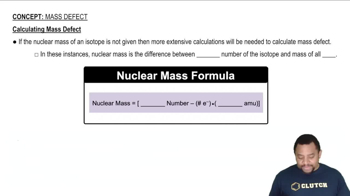Here are the essential concepts you must grasp in order to answer the question correctly.
Nuclear Fission
Nuclear fission is a process in which a heavy nucleus, such as plutonium-239, splits into two or more lighter nuclei, along with the release of energy. This reaction typically occurs when the nucleus absorbs a neutron, becoming unstable and breaking apart. The energy released during fission is due to the conversion of mass into energy, as described by Einstein's equation E=mc².
Recommended video:
Band of Stability: Nuclear Fission
Energy Release in Reactions
In chemical and nuclear reactions, energy can be released or absorbed. For fission reactions, the energy produced is often measured in kilojoules per mole (kJ/mol). This energy release is a result of the strong nuclear forces that bind protons and neutrons in the nucleus, and when these bonds are broken, energy is released, which can be harnessed for power generation.
Recommended video:
Gibbs Free Energy of Reactions
Calculating Energy from Mass Defect
The energy produced in a fission reaction can be calculated using the mass defect, which is the difference between the mass of the original nucleus and the total mass of the resulting fragments. This mass defect is converted into energy using Einstein's equation E=mc². Understanding how to calculate the mass defect is essential for determining the energy output of the fission reaction.
Recommended video:



